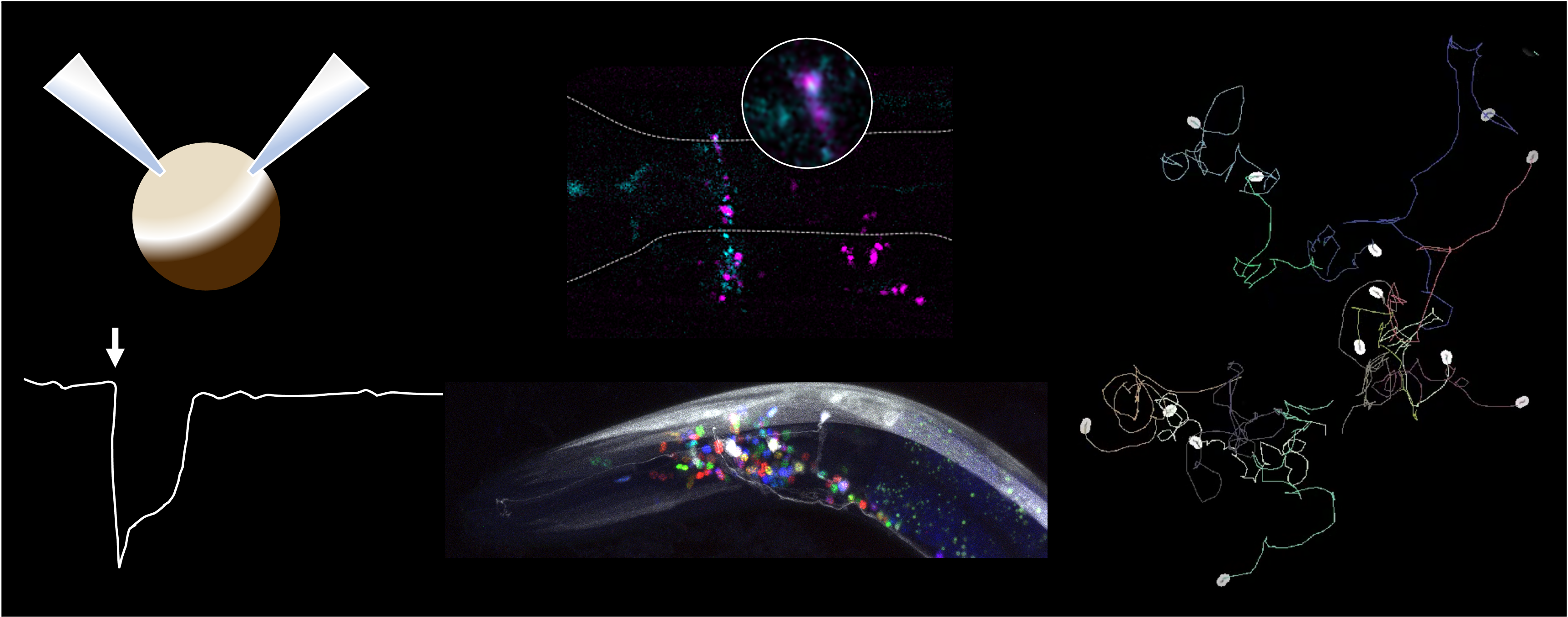
Image: Overview of project techniques (left to right): Two electrode voltage clamp to characterise novel receptors, Confocal and expansion microscopy to localise receptors, animal tracking and behavioural experiments to understand the role of receptors in vivo.
How do small nervous systems generate complex behaviour?
Supervisor: Dr Iris Hardege
Co-supervisor: Prof Howard Baylis
Traditionally we believe that the ability to perform complex behaviour arises as the size of the brain increases. However, animals with anatomically small brains, like the nematode C. elegans, are capable of complex behaviours such as learning and maze navigation. This raises the question; how do these small networks generate behavioural complexity and are these mechanisms conserved throughout evolution?
Recently we discovered the surprising extent to which the worm nervous system encodes both excitatory and inhibitory fast-acting ligand gated ion channel receptors (LGICs) for the same neurotransmitter, providing clues into the mechanism the worm nervous system uses to generate complex behaviours. One of our most surprising and exciting findings was the identification of both excitatory and inhibitory dopamine gated ion channels. Most of our understanding of dopamine signalling comes from the mammalian system which employs only (G-protein coupled receptors) GPCRs, our findings suggest however that dopamine may also act synaptically via fast neurotransmission. We now want to understand how the worm nervous system harnesses this complex mix of receptors to perform behaviour and regulate learning.
The project will involve characterising the localisation of these novel dopamine and other receptors down to the synaptic level, testing the behaviour of animals with specific mutations including in learning assays, studying the electrophysiological properties of novel receptors, and generating computational models of the worm nervous system. Working with this established model organism will give you the opportunity to learn and apply a wide range of techniques including genetics, molecular biology, confocal microscopy, and electrophysiology (two-electrode voltage clamp), as well as performing and analysing animal behaviour with tracking and computational methods.
References
Iris Hardege, J Morud, A Courtney, WR Schafer. A Novel and Functionally Diverse Class of Acetylcholine-gated Ion Channels. Journal of Neuroscience (2023) https://doi.org/10.1523/JNEUROSCI.1516-22.2022 Iris Hardege, J Morud, J Yu, TS Wilson, FC Schroeder, WR
Schafer. Neuronally Produced Betaine Acts via a Ligand Gated Ion Channel to Control Behavioural States. PNAS (2022) https://doi.org/10.1073/pnas.2201783119
J Morud, Iris Hardege, H Liu, T Wu, MK Choi, S Basu, Y Zhang, WR Schafer. Deorphanisation of novel biogenic amine-gated ion channels identifies a new serotonin receptor for learning. Current Biology (2021) https://doi.org/10.1016/j.cub.2021.07.036
